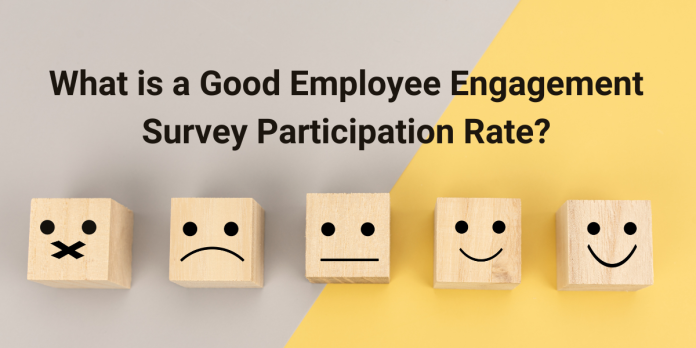
The participation rate in employee engagement surveys is a crucial initial statistic. You can calculate the response rate by dividing the number of surveys submitted by the number of employees invited to participate.
Significance of Response Rate
The response rate is a key indicator of data quality and completeness. High participation rates suggest the data is a reliable representation of the entire workforce. Conversely, low participation rates might undermine the data's accuracy and effectiveness, potentially leading to inadequate leadership decisions.
For managers, low response rates can hinder their ability to effectively use the survey results to foster positive organizational changes. Usually, there's a requirement for a minimum of four or five responses to maintain anonymity, which can restrict reporting in smaller groups. In such scenarios, the results are often combined with larger data sets for broader organizational analysis.
Ideal Participation Rates
According to a study by WSA, the global response rate for engagement surveys is in the range of 60% to 92% with with an average of 76%.
Response rates tend to be lower, the larger the company. CultureAmp recommends these target ranges:
- For companies with less than 500 employees, the ideal survey participation rate is 80% to 90%.
- For companies with 500 to 1000 employees, the ideal survey participation rate is 70% to 80%.
- For companies with more than 1000 employees, the ideal survey participation rate is 65% to 80%.
Is 100% Participation a Red Flag?
Achieving a 100% response rate in employee surveys is not always indicative of organizational health. In fact, it can be a warning sign.
Why might 100% be concerning? A perfect participation rate often comes with worrying undercurrents – indications of compelled responses, substantial missing data, or unhelpful feedback patterns, such as uniform agreement or disagreement. This scenario raises a red flag about the integrity and usefulness of the data. In corporate analytics, the focus should always lean towards data quality rather than sheer volume.
Typically, employee surveys aim for participation rates significantly higher than the 50% benchmark seen in U.S. elections, usually within the 65-85% range. These figures are enviable in the realms of political and market research, suggesting a level of engagement and representation that those fields can only aspire to achieve.
How to Increase Response Rates
Factors that can impact response rates include:
- Digital Access: Online survey accessibility significantly influences response rates. Sectors with limited computer access typically see lower participation. For instance, industries like transportation and utilities often record lower rates.
- Organizational Trust and Psychological Safety: The level of trust employees have in their organization, particularly regarding the confidentiality and impact of their feedback, greatly affects their willingness to participate. If employees perceive their feedback as inconsequential or not confidential, they might opt out of the survey.
Boosting engagement survey response rates requires efforts from HR, senior leadership, and management. Tactics include:
- Promotion and Communication: Publicizing the survey and explaining its purpose and potential impact can boost engagement. Strategies include poster campaigns, digital announcements, and strong support from senior leadership and managers.
- Feedback Loop: Demonstrating tangible changes resulting from past surveys encourages future participation.
- Survey Management: Keeping the survey short, and running the survey over a suitable duration, like two weeks, gives everyone a chance to contribute.
- Confidentiality Assurance: Reinforcing the anonymity of responses and considering adjusting the minimum response threshold can address confidentiality concerns.
Conclusion
Management, leadership, and project teams play a vital role in increasing engagement survey response rates. Their efforts in promoting participation, ensuring confidentiality, and demonstrating the impact of feedback are crucial in obtaining valuable and actionable insights from these surveys.
Significance of Response Rate
The response rate is a key indicator of data quality and completeness. High participation rates suggest the data is a reliable representation of the entire workforce. Conversely, low participation rates might undermine the data's accuracy and effectiveness, potentially leading to inadequate leadership decisions.
For managers, low response rates can hinder their ability to effectively use the survey results to foster positive organizational changes. Usually, there's a requirement for a minimum of four or five responses to maintain anonymity, which can restrict reporting in smaller groups. In such scenarios, the results are often combined with larger data sets for broader organizational analysis.
Ideal Participation Rates
According to a study by WSA, the global response rate for engagement surveys is in the range of 60% to 92% with with an average of 76%.
Response rates tend to be lower, the larger the company. CultureAmp recommends these target ranges:
- For companies with less than 500 employees, the ideal survey participation rate is 80% to 90%.
- For companies with 500 to 1000 employees, the ideal survey participation rate is 70% to 80%.
- For companies with more than 1000 employees, the ideal survey participation rate is 65% to 80%.
Is 100% Participation a Red Flag?
Achieving a 100% response rate in employee surveys is not always indicative of organizational health. In fact, it can be a warning sign.
Why might 100% be concerning? A perfect participation rate often comes with worrying undercurrents – indications of compelled responses, substantial missing data, or unhelpful feedback patterns, such as uniform agreement or disagreement. This scenario raises a red flag about the integrity and usefulness of the data. In corporate analytics, the focus should always lean towards data quality rather than sheer volume.
Typically, employee surveys aim for participation rates significantly higher than the 50% benchmark seen in U.S. elections, usually within the 65-85% range. These figures are enviable in the realms of political and market research, suggesting a level of engagement and representation that those fields can only aspire to achieve.
How to Increase Response Rates
Factors that can impact response rates include:
- Digital Access: Online survey accessibility significantly influences response rates. Sectors with limited computer access typically see lower participation. For instance, industries like transportation and utilities often record lower rates.
- Organizational Trust and Psychological Safety: The level of trust employees have in their organization, particularly regarding the confidentiality and impact of their feedback, greatly affects their willingness to participate. If employees perceive their feedback as inconsequential or not confidential, they might opt out of the survey.
Boosting engagement survey response rates requires efforts from HR, senior leadership, and management. Tactics include:
- Promotion and Communication: Publicizing the survey and explaining its purpose and potential impact can boost engagement. Strategies include poster campaigns, digital announcements, and strong support from senior leadership and managers.
- Feedback Loop: Demonstrating tangible changes resulting from past surveys encourages future participation.
- Survey Management: Keeping the survey short, and running the survey over a suitable duration, like two weeks, gives everyone a chance to contribute.
- Confidentiality Assurance: Reinforcing the anonymity of responses and considering adjusting the minimum response threshold can address confidentiality concerns.
Conclusion
Management, leadership, and project teams play a vital role in increasing engagement survey response rates. Their efforts in promoting participation, ensuring confidentiality, and demonstrating the impact of feedback are crucial in obtaining valuable and actionable insights from these surveys.





